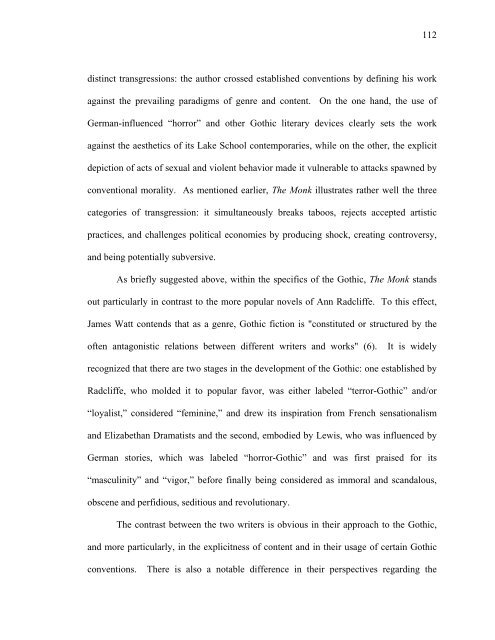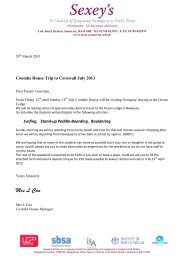Untitled - Sexey's School Moodle
Untitled - Sexey's School Moodle
Untitled - Sexey's School Moodle
You also want an ePaper? Increase the reach of your titles
YUMPU automatically turns print PDFs into web optimized ePapers that Google loves.
distinct transgressions: the author crossed established conventions by defining his work<br />
against the prevailing paradigms of genre and content. On the one hand, the use of<br />
German-influenced “horror” and other Gothic literary devices clearly sets the work<br />
against the aesthetics of its Lake <strong>School</strong> contemporaries, while on the other, the explicit<br />
depiction of acts of sexual and violent behavior made it vulnerable to attacks spawned by<br />
conventional morality. As mentioned earlier, The Monk illustrates rather well the three<br />
categories of transgression: it simultaneously breaks taboos, rejects accepted artistic<br />
practices, and challenges political economies by producing shock, creating controversy,<br />
and being potentially subversive.<br />
112<br />
As briefly suggested above, within the specifics of the Gothic, The Monk stands<br />
out particularly in contrast to the more popular novels of Ann Radcliffe. To this effect,<br />
James Watt contends that as a genre, Gothic fiction is "constituted or structured by the<br />
often antagonistic relations between different writers and works" (6). It is widely<br />
recognized that there are two stages in the development of the Gothic: one established by<br />
Radcliffe, who molded it to popular favor, was either labeled “terror-Gothic” and/or<br />
“loyalist,” considered “feminine,” and drew its inspiration from French sensationalism<br />
and Elizabethan Dramatists and the second, embodied by Lewis, who was influenced by<br />
German stories, which was labeled “horror-Gothic” and was first praised for its<br />
“masculinity” and “vigor,” before finally being considered as immoral and scandalous,<br />
obscene and perfidious, seditious and revolutionary.<br />
The contrast between the two writers is obvious in their approach to the Gothic,<br />
and more particularly, in the explicitness of content and in their usage of certain Gothic<br />
conventions. There is also a notable difference in their perspectives regarding the



